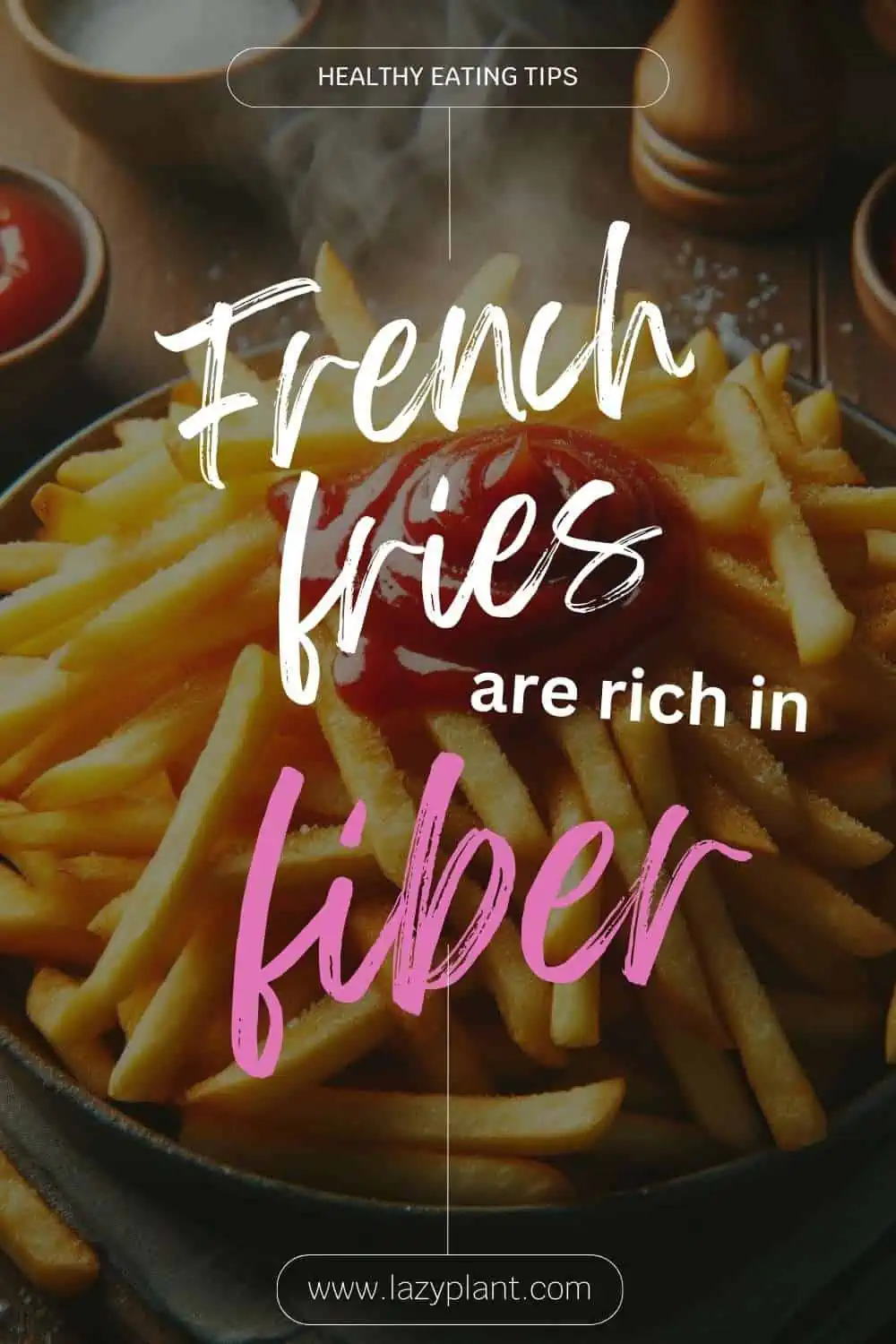A small cup of French fries provides about 3.5% of the Daily Value of fiber, as they contain up to 1.9 grams of fiber per 100g. Cooking methods don’t greatly affect fiber content. Hence, boiled or baked potatoes have a similar fiber content to French fries. A serving of your favorite potato recipe can provide up to 11% of the Daily Value!
How much fiber do we need a day?
We need about 28 grams of dietary fiber a day. High fiber intake is important for good health.
Most people who follow the standard Western diet fail to consume adequate amounts of fiber, though. Actually, about 95% of Americans don’t consume the recommended daily fiber intake.
Only plants are good dietary sources of fiber. Beans, legumes, vegetables, whole grains, nuts, seeds, and fruits are great sources.
A fiber-rich diet is good for you. But you have to gradually increase your fiber intake. You may experience bloating or stomach discomfort if you suddenly skyrocket your fiber intake.

How much fiber is in potatoes?
Actually, potatoes are good dietary sources of fiber. The fiber content of potatoes depends on the variety, the region of growth, and agricultural methods. Most commercial potato varieties have 1.4 grams of fiber per 100g.
As a rule of thumb, avoid peeling potatoes. The skin has approximately 1.8 times more fiber than the flesh. The skin of raw potatoes has about 2.5 grams of fiber per 100g. Raw potatoes with the skin have 2.1 grams of fiber per 100g.[1]
Certainly, you should only eat the skin of organic potatoes. The skin is richer in chemical pesticide residues than the flesh. Actually, potatoes are among the most pesticide-contaminated foods.[2]
How does cooking affect the fiber content of potatoes?
Each potato recipe has a different fiber content. The cooking method affects the fiber structure and water content of potatoes. Less water means higher fiber concentrations:
- Baked potatoes contain 1.5 grams of fiber per 100g. A large baked potato provides up to 6 grams of fiber or 21% DV. A cup of baked potatoes provides 7% DV.
- Boiled, roasted, or stewed potatoes have a slightly lower fiber content than baked potatoes because they have more water. Boiled potatoes have approximately 1.4 grams of fiber per 100g. A cup of boiled potatoes provides 2.2 grams of fiber or 8% DV.
- Ready-to-eat mashed potatoes are also good dietary sources of fiber. They contain between 1.3 and 1.9 grams of fiber per 100g. A cup provides 3.2 grams of fiber or 11% DV.
Consuming potatoes in moderation is good for weight loss. Actually, potatoes are among the most filling foods, due to their high fiber content. Other carbohydrate-rich foods, such as pasta or rice, aren’t as filling as boiled potatoes.
Are French fries high in dietary fiber?
Actually, French fries are particularly high in fiber. Frying increases the amount of resistant starch in potatoes.
In fact, French fries are the main sources of fiber for many people.
French fries contain between 1.6 and 1.9 grams of fiber per 100g. A small cup has about 1 gram of fiber or 3.5% of the Daily Value.
Certainly, you should avoid consuming commercial French fries. They have many calories, due to the added fat. Most noteworthy, they’re high in trans fat, which is dangerous for the heart.
You can easily prepare crunchy, tasteful, healthy, low-calorie French fries at home using an air fryer.
How much fiber is in other potato-based foods?
Actually, most potato-based products contain decent amounts of fiber. Fiber in potato foods can help us meet our daily needs!
| fiber (grams) per 100g | fiber (grams) per serving | |
| potato soup, instant, dry mix | 7.6 | 3 |
| potato bread | 6.3 | 2.7 |
| potato chips | 5.4 | 4.6 |
| potato sticks | 3.4 | 1 |
| potato pancakes | 3.3 | 1.2 |
| potato puffs | 2 | 1.6 |
| potato salad | 1.3 | 3.25 |
Potato flour is a good dietary source of fiber as well. It contains 5.4 grams of fiber per 100g. For comparison, white wheat flour has only 2.4 grams, while whole wheat flour has 10.6 grams of fiber per 100g.
Hence, potato bread, pancakes, and other potato-baked goods are rich in fiber. A large slice of potato bread provides up to 10% of the DV.
Potato salad and potato soup are also excellent dietary sources of fiber. A serving provides about 11% of the DV.
Other favorite potato products, like potato chips, puffs, and sticks, also contain decent amounts of fiber.
Keep in mind that commercial potatoes have many calories, salt, saturated and trans fat. Always check the nutrition facts label in order to make the healthiest choice.
According to the American Heart Association, we shouldn’t consume more than 13 grams of saturated fatty acids a day. High amounts of saturated fats may increase LDL cholesterol, and even increase the risk of heart disease and stroke. Excess salt is pretty bad for you as well.[3]
Potato is one of the richest vegetables in fiber!
You can substantially increase the total fiber intake by eating plenty of vegetables. Sweet potatoes, carrots, spinach, cabbage, kale, lettuce, arugula, celery, beets, and onions, are just some of the most common high-fiber vegetables.
How to eat French fries for boosting fiber intake?
As French fries are high in calories, eating them for fiber isn’t the healthiest food option. However, you can incorporate them into meals with other fiber-rich ingredients. Here are some meal ideas that include French fries while also providing a good dose of fiber:
Chickpea and veggie bowl: Serve French fries alongside a bowl filled with roasted chickpeas, sautéed vegetables (such as bell peppers, zucchini, and onions), and a drizzle of tahini sauce for added fiber and protein.
Quinoa and lentil plate: Prepare a plate with quinoa and lentils, and serve it with a side of baked French fries. Add chopped fresh vegetables, like cucumber and cherry tomatoes, for extra fiber. Lentils are among the healthiest foods you can eat for weight loss.
Black bean and veggie wrap: Create a wrap using whole-grain tortillas filled with black beans, lettuce, diced tomatoes, and baked French fries. Top with salsa or Greek yogurt for added flavor.

Mediterranean veggie platter: Pair French fries with a Mediterranean-inspired platter that includes hummus, olives, cherry tomatoes, cucumber slices, and whole-grain pita bread. This combination adds fiber and a variety of nutrients. Yes, French fries can be a part of Mediterranean cuisine when properly cooked.
Portobello mushroom burger: Make a vegetarian burger using a grilled portobello mushroom cap as the patty. Serve it with French fries and a side salad for additional fiber.
Veggie stir-fry with tofu: Stir-fry a mix of colorful vegetables, tofu, and your favorite sauce. Serve the stir-fry over a bed of brown rice or quinoa alongside baked sweet potato fries for a fiber-rich meal.
Vegetarian chili cheese fries: Top baked French fries with a hearty vegetarian chili, black beans, diced onions, and a sprinkle of cheese. This turns a classic comfort food into a fiber-packed dish.
Keep in mind that opting for baked or air-fried fries instead of deep-fried ones can enhance the overall healthiness of your meal.
How to cook potatoes for maximum fiber intake?
To maximize fiber intake when cooking potatoes, it’s important to retain the potato skins and choose cooking methods that preserve their nutritional content. Here are some cooking tips for maximum fiber:
Leave the skin on: The skin of the potato contains a significant amount of fiber. When preparing potatoes, scrub them thoroughly and leave the skin on to retain this valuable nutrient. You can wash your organic potatoes with this homemade water solution. It’s almost 99% more effective than tap water.
Bake or roast: Baking or roasting potatoes is a healthy cooking method that helps preserve their fiber content. Simply scrub the potatoes, cut them into your desired size, toss with a bit of olive oil, and season with herbs or spices. Bake in the oven until they are golden brown and tender.
Boiling with skin: If boiling potatoes, cook them with the skin on to prevent nutrient loss. After boiling, you can easily peel the skin if desired.
Steam: Steaming is another gentle cooking method that helps retain the fiber in potatoes. Steam whole potatoes until they are tender. This method preserves nutrients while keeping the potatoes moist.
Mashed with skin: When making mashed potatoes, consider mashing them with the skin on. Use a potato masher or fork to create a rustic texture, incorporating the fiber-rich skins.
Grilling: Grilling potatoes is a tasty option that imparts a smoky flavor. Brush sliced potatoes with a little olive oil and grill until they are cooked through. Grilling helps maintain the skin and fiber content.
Air-Frying: If you have an air fryer, use it to prepare crispy potato wedges with the skin on. This method requires less oil than deep-frying and helps retain nutrients.
Regular or sweet potatoes for fiber?
Sweet potatoes are also excellent dietary sources of fiber. Boiled sweet potatoes contain 2.5 grams of fiber per 100 g. A medium-boiled sweet potato (150 g) contains about 3.8 grams of fiber or 13% DV.
In fact, sweet potatoes have almost 80% more fiber than regular potatoes.
Most noteworthy, sweet potatoes offer additional nutritional benefits.